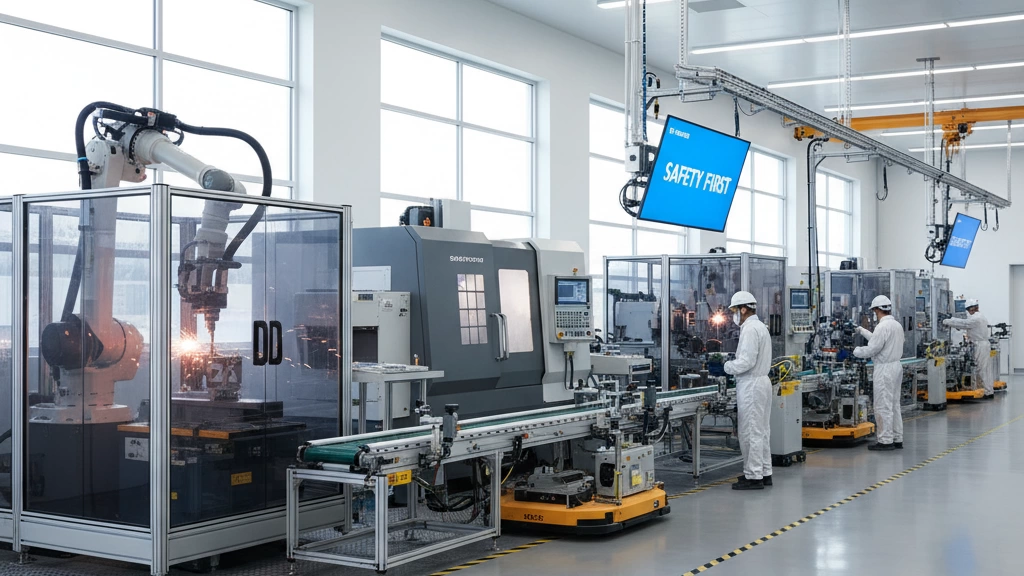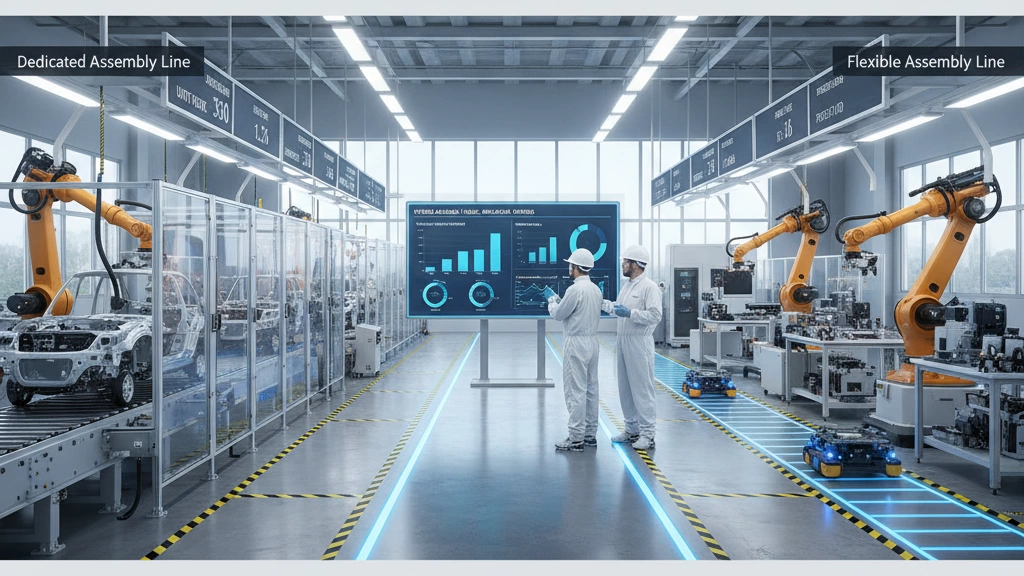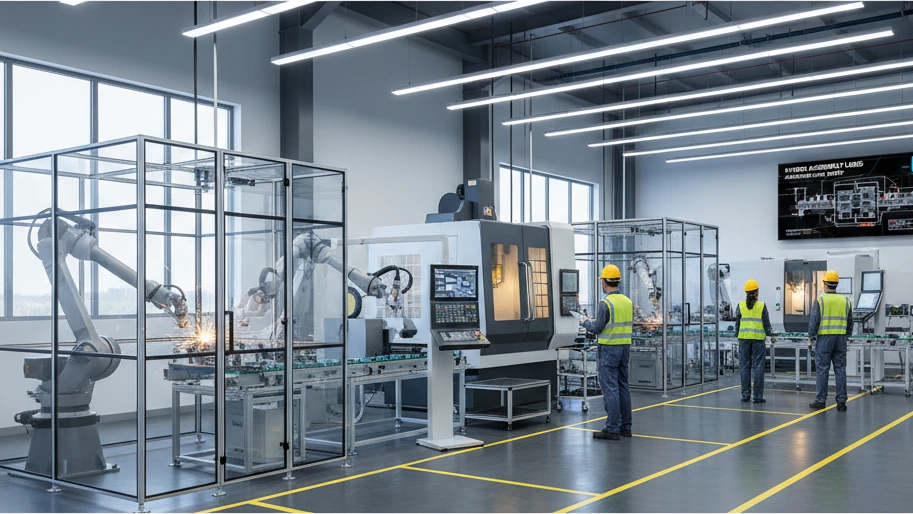Dedicated assembly lines shine in environments where speed and scale matter most. Their core strength lies in delivering the highest throughput and lowest per-unit cost when running high-volume, low-mix products—think automotive fasteners or standardized components. By focusing on a single product type, these lines optimize every step of production, squeezing out maximum efficiency.
However, this laser-focus on volume comes at a price. The biggest hidden cost is inflexibility during model changeovers. Unlike flexible lines, dedicated setups require significant downtime to switch between products. On average, a dedicated line’s changeover takes 4 to 8 hours, cutting sharply into productivity and increasing risks when frequent product changes are needed.
Key takeaway: Dedicated lines excel when your production runs are long and product variety is low. But if your product mix shifts often, those long changeovers become costly downtime you can’t ignore.
Fully flexible assembly lines are designed for maximum adaptability. Thanks to universal fixtures and automated systems, they enable zero downtime during changeovers, meaning the line can switch between different products without stopping production. This is a huge advantage for manufacturers dealing with high product variety.
However, this flexibility comes at a cost. Capital expenditures (CapEx) are typically 30–40% higher compared to dedicated lines due to the need for advanced robotics, complex programming, and more sophisticated control systems. Additionally, fully flexible lines often show lower overall equipment effectiveness (OEE) during steady-state operations because they sacrifice some throughput speed for versatility.
A notable case comes from a consumer electronics brand that initially embraced full flexibility but later reduced its SKU count and moved away from 100% flexible lines in favor of a more balanced approach. This shift highlights the challenges of maintaining full flexibility without sacrificing cost efficiency and throughput.
For more on balancing flexibility with efficiency, check out advanced line balancing optimization and practical insights on adaptive manufacturing systems.

Hybrid assembly lines combine the best of both worlds: a core dedicated backbone for efficiency, plus swappable modular stations for flexibility. This semi-flexible production approach allows manufacturers to maintain high throughput while adapting quickly to changing product mixes.
Key enablers making this possible include plug-and-play SMT feeders and robots, which can be swapped out without major disruptions. Digital twin line balancing tools optimize workflows in real time, ensuring smooth operations. Add to that adaptive grippers and advanced vision systems, and you get a line that can shift gears fast without compromising quality.
Jeenoce’s modular SMT solutions highlight this well — with pre-validated modules, they’ve cut line changeovers to under 30 minutes, a massive improvement over traditional setups. You can discover more about their automated SMT solutions and how modular assembly line design drives changeover time reduction here.

When deciding between dedicated, fully flexible, and hybrid assembly lines, four main metrics are critical: changeover time, CapEx (capital expenditure), OEE (overall equipment effectiveness), and scalability. Here’s a quick breakdown:
| Metric | Dedicated Assembly Lines | Fully Flexible Assembly Lines | Hybrid (Modular) Assembly Lines |
|---|---|---|---|
| Changeover Time | 4–8 hours (long, disruptive) | Near zero downtime (instant changeover) | Under 30 minutes (fast with modular swaps) |
| CapEx | Lowest upfront cost | 30–40% higher investment (complex setup) | Moderate CapEx; less than flexible but above dedicated |
| OEE | Highest in steady-state | Lower due to complexity and programming | High OEE with adaptive optimization |
| Scalability | Limited by fixed tooling | High, but costly to scale broadly | Very flexible; add or swap modules easily |
Key takeaway: Dedicated lines win on cost and steady throughput but struggle with flexibility and downtime during changeovers. Fully flexible lines offer maximum adaptability but at a premium price and complexity. Hybrid models hit a sweet spot — delivering fast changeovers, balanced costs, superior OEE, and scalable growth through modular automation.
For more on how line balancing and modular integration reshape these metrics, check out digital line balancing solutions and our guide to modular SMT lines.

Hybrid assembly lines are proving their worth by combining the best of dedicated and fully flexible systems. Here’s why they’re taking the lead:
60% Faster Changeovers
Thanks to pre-kitted, swappable modules, changeovers happen in a fraction of the time compared to traditional lines. This speed means less downtime and quicker responses to market shifts.
25% ROI Uplift Through Line Balancing Algorithms
Advanced line balancing software optimizes workflow by evenly distributing tasks and minimizing bottlenecks. This boosts overall efficiency and drives a clearer return on investment.
Risk Mitigation by Isolating Disruptions
With modular zones, any issue in a specific module won’t cripple the entire line. This containment reduces costly downtime and keeps production running smoothly.
Future-Proofing with Easy AI Vision Add-Ons
Instead of a costly full-line overhaul, hybrid lines let you integrate AI-powered vision systems module by module. This flexibility means staying ahead of tech trends without massive disruption.
Sustainability: 40% Less Energy Use
Hybrid setups consume significantly less energy compared to always-on fully flexible lines, thanks to targeted activation of only necessary modules. This supports greener manufacturing without sacrificing performance.
For manufacturers interested in optimizing changeover times and line efficiency, embracing modular automation solutions and digital line balancing tools unlocks substantial benefits.
The benefits of hybrid assembly lines aren’t just theory—they show up clearly in real operations. Take a medical device manufacturer that slashed their SMT line changeover time from 6 hours down to just 28 minutes. This drastic cut translated directly into a 92% improvement in on-time delivery, proving that faster, more flexible changeovers make a huge difference in meeting tight schedules.
In the automotive sector, a Tier-1 supplier used a hybrid retrofit to shrink their line footprint by 35%. This not only freed up valuable floor space but also improved production efficiency without sacrificing output. These examples highlight how a semi-flexible, modular assembly line can deliver significant ROI and operational improvements.
For more insights on modular SMT solutions and practical implementation, the Jeenoce resource on semi-flexible production techniques offers valuable guidance.
Moving to a hybrid assembly line? Here’s a simple, effective roadmap:
Map your product mix and volume clusters
Start by analyzing your product range and grouping based on volume and complexity. This helps identify which parts benefit most from dedicated automation and which need flexibility.
Design an 80% dedicated spine + 20% modular zones
Build a solid backbone focused on high-throughput for stable products. Around 20% of the line should be modular, with swappable stations ready for quick changeovers and adaptability.
Integrate digital line balancing with Jeenoce LineSync™
Use intelligent line balancing tools like Jeenoce LineSync™ to optimize throughput and reduce bottlenecks. This software adapts in real time to production needs, ensuring smooth workflows and better ROI.
Validate with simulation to reduce risk by 70%
Before full rollout, simulate the hybrid setup virtually. This step uncovers potential issues early, saving time and money on physical rework.
Scale via a growing module library
As new products or variations arise, reuse and adapt pre-validated modules for faster deployment. This modular approach future-proofs your line and improves scalability.
For custom automation integration and modular assembly line solutions that fit your production goals, explore Jeenoce’s product offerings for proven semi-flexible production systems built around smart factory changeovers.
The future of assembly lines is clearly leaning toward AI-driven hybrid models that combine flexibility with efficiency. One key trend is predictive changeover optimization, where AI analyzes production data to forecast the best time and method for switchovers, cutting downtime even further. Alongside this, autonomous module reconfiguration will allow individual sections of the line to self-adjust based on real-time demands without halting the entire process.
Jeenoce’s 2026 roadmap hints at a breakthrough: zero-touch line balancing. This means AI systems will automatically manage workflows, balancing load and resources across both dedicated and modular zones without human intervention. Such advancements promise to boost productivity, reduce errors, and help manufacturers stay agile amid shifting market needs.
For companies looking to stay ahead, exploring the latest in adaptive manufacturing systems and smart factory changeovers is essential. Jeenoce’s ongoing innovations in digital line balancing showcase practical steps already transforming production lines today. For a deeper look into these smart automation trends, visit Jeenoce's dedicated page.
Message